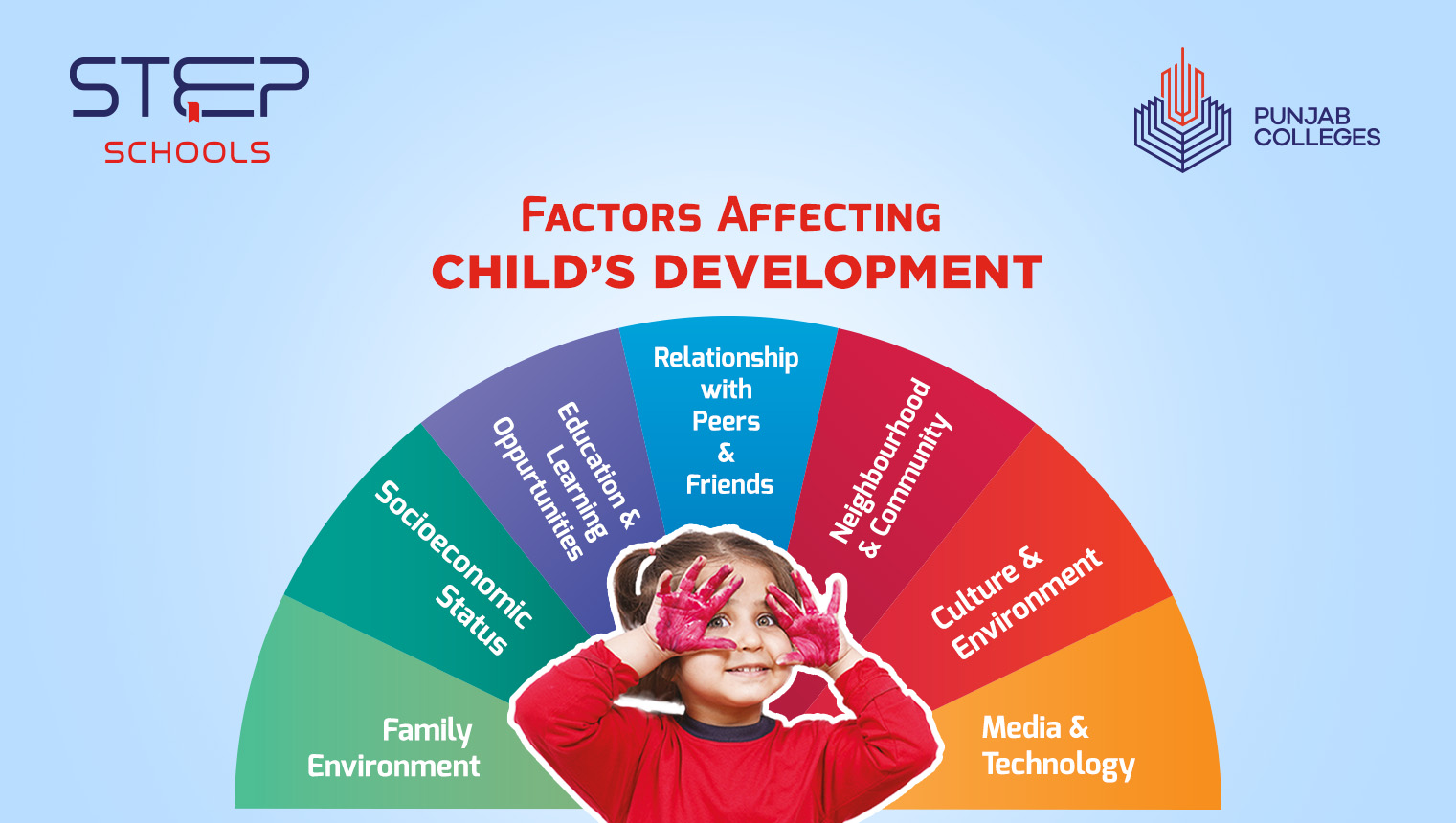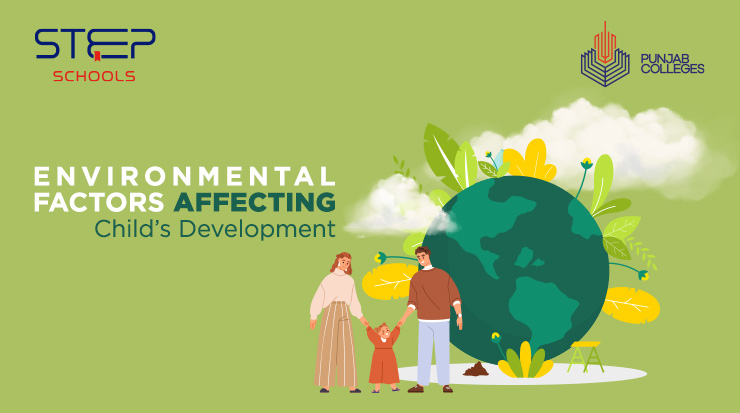A child’s development is a complex and dynamic process influenced by various factors. While genetic elements play a defining role in shaping a child’s potential, environmental factors also have a profound impact on a child’s development. Among these environmental factors, the surroundings in which a child grows and the experiences they encounter are particularly influential. In this blog post on STEP schools’ website, we will look into the environmental factors affecting child’s development and why parents, schools, and other institutions and society must pay attention to these factors.
Internal and External Environmental Factors Affecting Child’s Development
We spend our lifetime in a combination of internal and external environmental factors. Similarly, these elements heavily influence the development of our children. In the following passage, these features are addressed.
- Internal Factors
- External Factors
Internal Factors include the personality traits of any person. For instance, heredity, biological or constitutional factors, intelligence, emotional placements, and social nature of a child would fall under the internal points. Furthermore, these factors are heavily influenced by the external environmental factors affecting child’s development.
On the other hand, the external factors of influence affecting the child’s development are as follows.
Family Environment
The family is often considered the primary and prominent external environmental factor in a child’s development. A child’s bonding with parents, siblings, and other family members impacts their social, emotional, and cognitive development.
A loving and supportive family environment can provide a strong foundation for a child’s well-being. In contrast, a turbulent or neglectful family scenario leads to emotionally and psychologically unbalanced and disturbed children.
As a result, during their childhood and even their growing years (teenage), for example, the source of support and love is explored through friends and society, which increases the risk of lousy influence for a child because they are disconnected from their homes and families.
Socioeconomic Status of a Family
A family’s socioeconomic status is decisive in a child’s development. Families with higher socioeconomic status often have access to better educational opportunities, healthcare and treatment facilities, and a more vibrant environment. In contrast, children from lower-income families may face limited or no access to resources and may experience multiple stress factors that can sabotage their development. Hence, efforts to reduce economic problems and provide equal reach to quality education and healthcare are essential in promoting healthy child development.
Education and Learning Opportunities
Easy Access to quality and high education and learning opportunities is a critical environmental factor in a child’s cognitive development. Early childhood education programs, stimulating educational materials, and access to good schools can push intellectual growth and prepare children for future success. Parents and schools can support their child’s development by encouraging learning and reading and providing a rich learning environment.
Furthermore, schools must ensure to provide the education that is relevant for the years to come. Hence, STEP schools offer the 21st-century curriculum with a proper inclusion of robotics and STEAM education.
Relationships with Friends and Peers
Interactions with peers are an essential part of a child’s social development. These relationships help children to develop social skills, empathy, teamwork, and cooperation. Positive peer relationships can contribute to a child’s self-esteem and emotional well-being. However, negative peer interactions, such as bullying or exclusion, can have adverse effects on a child’s self-esteem and mental health.
For the same reason, STEP Schools promote the values of teamwork and community management through curricular and co-curricular activities.
Neighbourhood and Community
The neighbourhoods and communities in which a child lives can have a notable impact on their development. Access to safe parks, recreational activities, and community support services can contribute to a child’s physical and social development. On the other hand, living in a neighbourhood with high crime rates and limited opportunities can reverse a child’s overall well-being.

Cultural and Environmental Exposures
Cultural and environmental exposures, including exposure to art, music, and nature, can enrich a child’s development. These experiences can stimulate creativity, critical thinking, and emotional expression. Exposure to diverse cultures and backgrounds can also foster tolerance and empathy in children. For instance, children’s growth is further divided into biological and physical environments.
The biological environment depends upon gender, genes, nutrition and metabolism. The genes and gender are not in our control. However, we can strengthen the metabolism through proper nourishment and healthy food intake.
Climate change and poor air quality is the primary concern in Pakistan. In addition, smog is also a damaging environmental factor affecting a child’s development. As we are heading towards the winter and smog season is coming beforehand. Therefore, parents and schools must spread awareness and take steps to keep the children safe to the possible extent because environmental factors are directly linked with health issues.
Furthermore, a healthy and breathing-safe atmosphere is also essential for all. Therefore, it must be ensured to promote a healthy and breathable atmosphere. Families and schools can contribute massively to this regard.
- Explore plantation
- Encourage your kids to stay close to nature
- Promote diversified team tasks through STEAM education
- Teach essential health and hygienic manners through practice
- Develop the habits of healthy eating & stay hydrated
Media and Technology
In today’s digital age, media and technology are an integral part of a child’s environment. The content children consume through screens can influence their attitudes, behaviour, and cognitive development. Parents and schools need to monitor and control the quality and quantity of media exposure to ensure it aligns with a child’s developmental needs.
In this regard, parents can watch out and regularise what their children consume through mobile, television, and the internet. In addition, the schools can also engage their students in e-learning. Furthermore, schools and parents can equally encourage the kids to develop the habit of reading.
Staying ahead of children to provide the healthy environmental factors affecting a child’s development can be getting into discussions and talking on a daily or frequent basis. This exercise will help in relationship and trust building, and the chances of keeping your child safe are enhanced.
Conclusion
Environmental factors play an important role in shaping a child’s development. Parents, caregivers, educators, and society must recognise the essence of these factors and work collectively to provide children with the best possible environments for growth. By creating supportive, nurturing, and stimulating environments, we can help children reach their full potential and ensure a brighter future for the next generation. It is our responsibility to understand and address the environmental factors affecting child’s development to help every child thrive and succeed in life.

